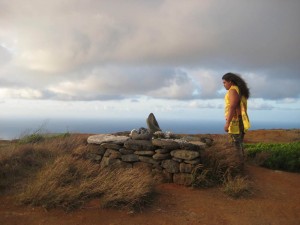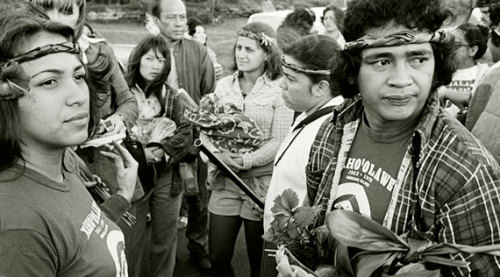When we talk about repatriation and laws such as NAGPRA we mainly focus on indigenous peoples of the continental United States and tend to forget about Native Hawaiians and Alaskan Native groups. The main focus of this blog will be Hawai’i simply because I have more knowledge about Native Hawaiian studies and Hawaiian history after spending a semester at the University of Hawai’i at Manoa.

Native Hawaiian activism and grievances against the United States government parallels those of Native Americans in many ways. Around the same time the American Indian Movement (AIM) was gaining momentum during the 1960s and 70s, Native Hawaiian activists were also coming together to protect their land and revitalize their language and culture. One of the most significant Native Hawaiian organizations of the 1970s was the Protect Kaho’olawe Ohana (PKO). The main goal of PKO during the 1970s was to stop U.S. military bombing of the sacred island of Kaho’olawe. After the Japanese attack on Pearl Harbor in 1941, Hawai’i which was then a U.S. territory was placed under martial law and the island of Kaho’olawe was taken over for military use as a training ground and target practice site.

In 1976, about 5 years after the American Indian Movement (AIM) protested the U.S. government by occupying the island of Alcatraz, PKO and Native Hawaiian activists attempted to regain control of their Native land by taking over Kaho’olawe. While the activists’ illegal occupation of Kaho’olawe sent a clear message, PKO eventually took legal action. In 1976 the PKO “filed suit in the Federal District Court for the District of Hawaii to stop the Navy’s use of Kahoolawe for military training, to require compliance with a number of new environmental laws, and to ensure protection of cultural resources on the island. The court allowed the Navy to continue using the island, but directed it to prepare an environmental impact statement and complete an inventory of historic sites on the island. In 1980 the Navy and the Protect Kahoolawe Ohana entered into a Consent Decree. This agreement allowed continued military training on the island, monthly access to the island for the PKO, surface clearance of part of the island, soil conservation, goat eradication, and an archeological survey. In 1981, the island of Kahoolawe was placed on the National Register of Historic Places.” (http://www.oahu.us/kahoolawe.htm).

Although the court’s decision required the U.S. government and military to recognize the cultural and historic significance of Kaho’olawe to Native Hawaiians, it made no effort to return control of the island to Native Hawaiians, and allowed the military to continue training and control access to the island. Up until 2003 the U.S. government restricted Native Hawaiian’s access to the island for religious and cultural purposes to a determined time each month. While the state of Hawai’i now has control over the island of Kaho’olawe it still limits access to the island to a few days each month. Kaho’olawe has become uninhabitable because of the destruction caused by the U.S. military and colonial introduction of feral goats. Access to the island is mostly restricted to volunteer groups that have been working to restore the island and its vegetation.
While the Hawaiian government has attempted to right the wrongs of the past by preventing commercial activities on Kaho’olawe and focusing on preserving the island exclusively for traditional Hawaiian cultural, spiritual and subsistence purposes, it is still problematic that Native Hawaiians cannot freely access their sacred lands without government intervention and restrictions.
Additional Readings:
PKO and Native Hawaiians Fight for Kaho’olawe:
http://the.honoluluadvertiser.com/article/2006/Jan/30/ln/FP601300338.html
Promised Land: Will Kaho’olawe Ever be Saved?
http://www.civilbeat.com/2014/10/promised-land-will-kahoolawe-ever-be-saved/
Sources Cited:
Photo 1- http://luatechnologies.tumblr.com/page/44
Photo 2- By Ronen Zilberman, Star Bulletin http://archives.starbulletin.com/2001/02/01/news/story4.html
Photo 3- http://www.nlm.nih.gov/exhibition/avoyagetohealth/exhibition-reclaiming-island.html
http://www.oahu.us/kahoolawe.htm
http://standingonsacredground.org/film-series/islands-sanctuary/kahoolawe-hawaii/site-report-kahoolawe-hawaii
